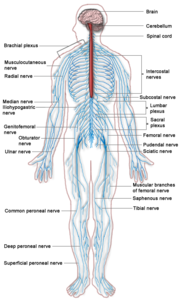Nervous System
Nerve Impulse

When a stimulus is strong enough, a nerve impulse is generated in an "all or none" response which means that a stimulus strong enough to generate a nerve impulse has been given. The stimulus triggers chemical and electrical changes in the neuron. Before an impulse is received, a resting neuron is polarized with different charges on either side of the cell membrane. The exterior of the cell is positively charged with a larger number of sodium ions present compared to the interior of the cell. The interior of the cell is negatively charged since it contains more potassium ions than the exterior of the cell. As a result of the differences in charges, an electro-chemical difference of about -70 millivolts occurs. The sodium-potassium pump, a system which removes sodium ions from inside the cell and draws potassium ions back in, maintains the electrical balance of the resting cell. Since the cell has to do work to maintain the ion concentration, ATP molecules are used to provide the
The human nervous system.
The type of response by the receiving cell may be excitatory or inhibitory depending upon a number of factors including the type of neurotransmitters involved. All nerve impulses are the same whether they originate from the ear, heart, or stomach. How the impulse is interpreted is the job of the central nervous system. A blow to the head near the optic center of the brain produces the same results as though the impulse had originated in the eyes. The neurons are the functional units of the nervous system through which coordination and control in organisms is executed.
See also Neuron; Neurosurgery; Neurotransmitter.
Resources
Books
BSCS Revision Team. Biological Science: A Molecular Approach. Lexington, MA: D.C. Heath & Co., 1990.
Campbell, Neil A. Biology. Menlo Park, CA: Benjamin/Cummings, Publishing Company, 1987.
Carey, Joseph, ed. Brain Facts: A Primer on the Brain and the Nervous System. Washington, DC: Society for Neuroscience, 1993.
Curtis, Helena, and N. Sue Barnes. Biology. 5th ed. New York: Worth Publishers, 1989.
Holtzman, Eric, and Alex B. Novikoff. Cells and Organelles. Philadelphia: Saunders College Publishing, 1984.
Kuffler, Stephen W., and John G. Nicholls. From Neuron to Brain. Sunderland, MA: Sinauer Associates, 1976.
Pine, Maya, ed. Seeing, Hearing and Smelling The World. Chevy Chase: Howard Hughes Medical Institute, 1995.
Purves, Dale. Body and Brain: A Trophic Theory of Neural Connections. Cambridge: Harvard University Press, 1988.
Raven, Peter H., and George B. Johnson. Biology. 3rd ed. St. Louis: Mosby Year Book, 1992.
Towle, Albert. Modern Biology. Austin, TX: Holt, Reinhart, and Winston, 1991.
Mary Finley
Additional topics
Science EncyclopediaScience & Philosophy: Mysticism to Nicotinamide adenine dinucleotideNervous System - Evolution Of Invertebrate Nervous Systems, Evolution Of The Vertebrate Nervous System, Central Nervous System, Peripheral Nervous System